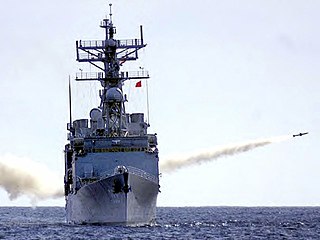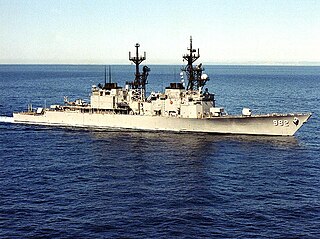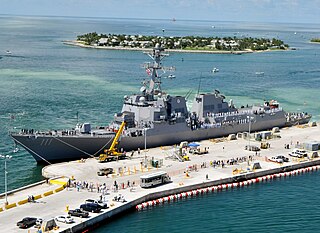
USS Hull (DD-945), named for Commodore Isaac Hull USN, was a Forrest Sherman-class destroyer built by the Bath Iron Works Corporation at Bath in Maine. Laid down on 12 September 1956 and launched 10 August 1957, by Mrs. Albert G. Mumma.

The Spruance-class destroyer was developed by the United States to replace the many World War II–built Allen M. Sumner- and Gearing-class destroyers, and was the primary destroyer built for the United States Navy during the 1970s and 1980s. It was named in honor of U.S. Navy Admiral Raymond A. Spruance, who successfully led major naval battles in the Asiatic-Pacific Theater during World War II such as the Battle of Midway and the Battle of the Philippine Sea.

USS Spruance (DD-963) was the lead ship of the United States Navy's Spruance class of destroyers and was named after Admiral Raymond A. Spruance. Spruance was built by the Ingalls Shipbuilding Division of Litton Industries at Pascagoula, Mississippi, and launched by Mrs. Raymond A. Spruance. Spruance served in the U.S. Atlantic Fleet, assigned to Destroyer Squadron 24 and operating out of Naval Station Mayport, Florida. Spruance was decommissioned on 23 March 2005 and then was sunk as a target on 8 December 2006.

USS Paul F. Foster (DD-964), named for Vice Admiral Paul F. Foster USN (1889–1972), is a Spruance-class destroyer built by the Ingalls Shipbuilding Division of Litton Industries at Pascagoula, Mississippi. She was commissioned on 21 February 1976 and decommissioned on 27 March 2003. She is now ex-Paul F. Foster, serving as a Self Defense Test Ship for experimental U.S. Navy weapons and sensors. She is the last Spruance-class destroyer still afloat.

USS Hewitt (DD-966), named for Admiral H. Kent Hewitt USN (1887–1972), was a Spruance-class destroyer built by the Ingalls Shipbuilding Division of Litton Industries at Pascagoula, Mississippi and launched on 14 September 1974 by Mrs. Leroy Hewitt Taylor and Mrs. Gerald Hewitt Norton, daughters of Admiral Hewitt.

USS Elliot (DD-967) was a Spruance-class destroyer in the United States Navy. Built by the Ingalls Shipbuilding Division of Litton Industries at Pascagoula, Mississippi, the ship was named for Lieutenant Commander Arthur J. Elliot II, USN (1933–1968), who as commanding officer of Patrol Boat River Squadron 57, was killed in action in the Republic of Vietnam on 29 December 1968.

USS Peterson (DD-969), named for Lieutenant Commander Carl Jerrold Peterson (1936–1969), was a Spruance-class destroyer laid down by the Ingalls Shipbuilding Division of Litton Industries at Pascagoula, Mississippi. Peterson was sponsored by Mrs. Miriam C. Peterson, the mother of LCDR Carl J. Peterson. Matron of Honor was Peterson's sister, Mrs. John F. Elliott. She was commissioned on 9 July 1977 and decommissioned on 4 October 2002.

USS Oldendorf (DD-972), named for Admiral Jesse B. Oldendorf USN, was a Spruance-class destroyer built by the Ingalls Shipbuilding Division of Litton Industries at Pascagoula, Mississippi.

USS John Young (DD-973), named for Captain John Young, USN, was a Spruance-class destroyer of the United States Navy. The ship was built by the Ingalls Shipbuilding Division of Litton Industries at Pascagoula, Mississippi.

USS Merrill (DD-976), named for Rear Admiral Aaron Stanton Merrill USN (1890–1961), was a Spruance-class destroyer that entered service with the United States Navy in 1978. Merrill served as the US Navy's test platform for the Tomahawk cruise missile. In the 1980s, the destroyer took part in Operation Earnest Will in the Persian Gulf during heightened tensions with Iran. The destroyer was decommissioned in 1998. The vessel was used as a target ship in 2003 and sunk off Hawaii in 2003.

USS Conolly (DD-979), named for Admiral Richard Lansing Conolly USN, was a Spruance-class destroyer built by the Ingalls Shipbuilding Division of Litton Industries at Pascagoula, Mississippi.

USS Leftwich (DD-984) was a Spruance-class destroyer built by the Ingalls Shipbuilding Division of Litton Industries at Pascagoula, Mississippi. She was named for Lieutenant Colonel William G. Leftwich, Jr., USMC (1931–1970), commander of the 1st Reconnaissance Battalion who was killed in action during Operation Imperial Lake in Quảng Nam Province South Vietnam on 18 November 1970 in a helicopter crash during the extraction of one of his reconnaissance teams. For this action, Lieutenant Colonel Leftwich received the Silver Star. Lieutenant Colonel Leftwich's medals and awards include: the Navy Cross, the Silver Star (posthumous), the Legion of Merit with Combat "V" and two gold stars, the Meritorious Service Medal, the Air Medal with one gold star, the Purple Heart with two gold stars, and various personal awards from the Republic of Vietnam.

USS Cushing (DD-985), named after Commander William Barker Cushing, was the fifth ship of the United States Navy to bear the name. Cushing was a Spruance-class destroyer built by the Ingalls Shipbuilding Division of Litton Industries at Pascagoula, Mississippi. Cushing operated out of Yokosuka, Japan for the last several years of her career. Cushing was the last Spruance-class destroyer to remain in active service, until decommissioned on 21 September 2005.

USS Fletcher (DD-992), the thirtieth Spruance-class destroyer, was part of the first major class of United States Navy surface ships to be powered by gas turbines. She was commissioned in July 1980 and was deployed mainly in the western and southern Pacific, but also voyaged to the Indian Ocean and Persian Gulf. She was the second ship in the U.S. Navy to bear this name but the first to be named after Admiral Frank Friday Fletcher, AndFrank Jack Fletcher. After her decommissioning in 2004, she was sunk in a torpedo test exercise in 2008.

USS O'Bannon (DD-987), a Spruance-class destroyer, was the third ship of the United States Navy to be named for Lieutenant Presley O'Bannon (1776–1850), an early hero of the US Marine Corps.

USS Nicholson (DD-982), a Spruance-class destroyer, was the fourth ship of the United States Navy to be named for a family which was prominent in early American naval history, including James Nicholson, the senior Continental Navy Captain, and Samuel Nicholson, the first captain of USS Constitution.

USS Deyo (DD-989), a Spruance-class destroyer, was a ship of the United States Navy named for Vice Admiral Morton L. Deyo (1887–1973), a veteran destroyerman and distinguished naval gunfire support task force commander of World War II.

USS Fife (DD-991), a Spruance-class destroyer, was a ship of the United States Navy named for Admiral James Fife, Jr. (1897–1975), a distinguished Submarine Force commander during World War II.

USS Spruance (DDG-111) is a United States Navy Arleigh Burke-class destroyer. She is the 61st ship in her class. Spruance is the second ship to be named for Admiral Raymond A. Spruance (1886–1969), who commanded American naval forces at the Battles of Midway and the Philippine Sea. He was later Ambassador to the Philippines. Her keel was laid down on 14 May 2009. She was christened by the admiral's granddaughter, Ellen Spruance Holscher, on 5 June 2010 in Bath, Maine at Bath Iron Works, where the ship was built at a cost of $1 billion. The completed ship left Bath on 1 September 2011 for her commissioning in Key West, Florida on 1 October 2011.

Stephen Scott Clarey is a retired United States Navy rear admiral who commanded the U.S. Maritime Prepositioning Force during Operation Desert Shield and the Pacific Fleet/5th Marine Expeditionary Brigade Amphibious Task Force during Operation Desert Storm. He retired from the navy in August 1992 after thirty years of service.


























